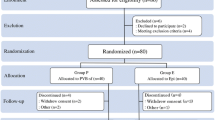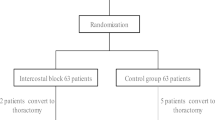Abstract
Purpose
Both paravertebral block (PVB) and thoracic epidural block (TEB) are recommended for postoperative pain relief after lung surgery. The addition of fentanyl to the anesthetic solution became popular for TEB because of the stronger effects; however, there have been few comparable trials about the addition of fentanyl to PVB. The purpose of this study was thus to compare postoperative analgesia, side effects, and complications between ultrasound-guided PVB (USG-PVB) and TEB with the addition of fentanyl to ropivacaine after lung surgery.
Methods
We examined 90 consecutive patients (age 18–75 years) scheduled for video-assisted thoracic surgery (VATS). In both groups, all blocks (four blocks in USG-PVB and one block in TEB) and one catheter insertion were performed preoperatively. Continuous postoperative infusion (0.1 % ropivacaine plus fentanyl at 0.4 mg/day) was undertaken for 36 h in both groups. The recorded data included the verbal rating scale (VRS) for pain, blood pressure, side effects, complications for 2 days, and overall satisfaction score.
Results
There was no difference in the frequency of taking supplemental analgesics (twice or more frequently), or in VRS. Hypotension occurred significantly more frequently in TEB (n = 7/33) than in PVB (n = 1/36) (P = 0.02); on the other hand, the incidences of PONV and pruritus, as well as overall satisfaction score, were similar. There were no complications in both groups; however, the catheters migrated intrathoracically in four patients in PVB.
Conclusion
USG-PVB achieved similar pain relief and lowered the incidence of hypotension compared with TEB. We conclude that both blocks with the same concentration of ropivacaine and fentanyl can provide adequate postoperative analgesia for VATS.



Similar content being viewed by others
References
Davies RG, Myles PS, Graham JM. A comparison of the analgesic efficacy and side-effects of paravertebral vs epidural blockade for thoracotomy—a systematic review and meta-analysis of randomized trials. Br J Anaesth. 2006;96:418–26.
Joshi GP, Bonnet F, Shah R, Wilkinson RC, Camu F, Fischer B, Neugebauer EA, Rawal N, Schug SA, Simanski C, Kehlet H. A systematic review of randomized trials evaluating regional techniques for postthoracotomy analgesia. Anesth Analg. 2008;107:1026–40.
Macias A, Monedero P, Adame M, Torre W, Fidalgo I, Hidalgo F. A randomized, double-blinded comparison of thoracic epidural ropivacaine, ropivacaine/fentanyl, or bupivacaine/fentanyl for postthoracotomy analgesia. Anesth Analg. 2002;95:1344–50.
Kotzé A, Scally A, Howell S. Efficacy and safety of different techniques of paravertebral block for analgesia after thoracotomy: a systematic review and metaregression. Br J Anaesth. 2009;103:626–36.
Richardson J, Sabanathan S, Jones J, Shah RD, Cheema S, Mearns AJ. A prospective, randomized comparison of preoperative and continuous balanced epidural or paravertebral bupivacaine on post-thoracotomy pain, pulmonary function and stress responses. Br J Anaesth. 1999;83:387–92.
Bimston DN, McGee JP, Liptay MJ, Fry WA. Continuous paravertebral extrapleural infusion for post-thoracotomy pain management. Surgery. 1999;126:650–6.
Sandler AN, Stringer D, Panos L, Badner N, Friedlander M, Koren G, Katz J, Klein J. A randomized, double-blind comparison of lumber epidural and intravenous fentanyl infusions for postthoracotomy pain relief. Analgesic, pharmacokinetic, and respiratory effects. Anesthesiology. 1992;77:626–34.
Loper KA, Ready LB, Downey M, Sandler AN, Nessly M, Rapp S, Badner N. Epidural and intravenous fentanyl infusions are clinically equivalent after knee surgery. Anesth Analg. 1990;70:72–5.
George MJ. The site of action of epidurally administered opioids and its relevance to postoperative pain management. Anaesthesia. 2006;61:659–64.
Ginosar Y, Riley ET, Angst MS. The site of action of epidural fentanyl in humans: the difference between infusion and bolus administration. Anesth Analg. 2003;97:1428–38.
Purcell-Jones G, Pither CE, Justins DM. Paravertebral somatic nerve block: a clinical, radiographic, and computed tomographic study in chronic pain patients. Anesth Analg. 1989;68:32–9.
Cowie B, McGlade D, Ivanusic J, Barrington MJ. Ultrasound-guided thoracic paravertebral blockade: a cadaveric study. Anesth Analg. 2010;110:1735–9.
Luyet C, Eichenberger U, Greif R, Vogt A, Farkas ZS, Moriggl B. Ultrasound-guided paravertebral puncture and placement of catheters in human cadavers: an imaging study. Br J Anaesth. 2009;102:534–9.
Richardson J, Cheema SP, Hawkins J, Sabanathan S. Thoracic paravertebral space location. A new method using pressure measurement. Anaesthesia. 1996;51:137–9.
Author information
Authors and Affiliations
Corresponding author
About this article
Cite this article
Okajima, H., Tanaka, O., Ushio, M. et al. Ultrasound-guided continuous thoracic paravertebral block provides comparable analgesia and fewer episodes of hypotension than continuous epidural block after lung surgery. J Anesth 29, 373–378 (2015). https://doi.org/10.1007/s00540-014-1947-y
Received:
Accepted:
Published:
Issue Date:
DOI: https://doi.org/10.1007/s00540-014-1947-y




